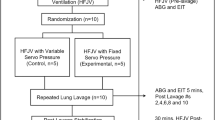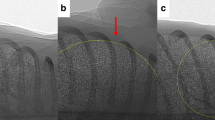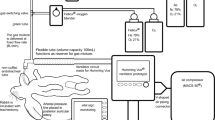Abstract
ABSTRACT: We studied healthy and saline lavaged rabbits during high frequency oscillatory ventilation to determine what combination of frequency (f), tidal volume (Vt), and mean airway pressure (Paw) produced the lowest peak-to-peak alveolar pressure amplitude (Palv) and physiologic blood gas tensions. Sinusoidal volume changes were delivered through a tracheostomy by a piston pump driven by a linear motor. Tracheal pressure amplitude (Ptr) was measured through a tracheal catheter and alveolar pressure amplitude was measured in a capsule glued to the right lower lobe. Pao2, Paco2, Ptr, and Palv were measured at the following settings: FiO2 = 0.5, frequency 2-28 Hz, V, 1-3 mL/kg (50 150% dead space) and Paw 5-15 cm H2O. Many combinations of frequency and Vt resulted in the same Pao2 and Paco2. Paw had a large effect on Palv and minimal effect on blood gas tensions. In lavaged rabbits, the composite variable f × Vt2 described the trends in Palv and blood gas tensions. As the product of f × Vt2 increased, Pao2 initially increased and then decreased, whereas Paco2 decreased and Palv increased. No single combination of frequency, Vt and Paw simultaneously provided the lowest Palv and physiologic blood gas tensions. Adequate blood gas tensions and low Palvwere obtained at frequencies less than 12 Hz, a V, of 2 mL/kg and a Paw of 10 cm H2O. In healthy and lavaged rabbits Pao2 increased and Paco2 decreased as frequency increased at lower Vt · Pao2 decreased as frequency increased at higher Vt in lavaged rabbits only. Palvtended to be greater in lavaged rabbits.
Similar content being viewed by others
Article PDF
Author information
Authors and Affiliations
Rights and permissions
About this article
Cite this article
Kamitsuka, M., Boynton, B., Villanueva, D. et al. Frequency, Tidal Volume, and Mean Airway Pressure Combinations that Provide Adequate Gas Exchange and Low Alveolar Pressure during High Frequency Oscillatory Ventilation in Rabbits. Pediatr Res 27, 64–69 (1990). https://doi.org/10.1203/00006450-199001000-00018
Received:
Accepted:
Issue Date:
DOI: https://doi.org/10.1203/00006450-199001000-00018
This article is cited by
-
Use of very low tidal volumes during high-frequency ventilation reduces ventilator lung injury
Journal of Perinatology (2019)
-
High frequency oscillation
European Journal of Pediatrics (1994)
-
High frequency oscillatory ventilation near resonant frequency of the respiratory system in rabbits with normal and surfactant depleted lungs
European Journal of Pediatrics (1991)



